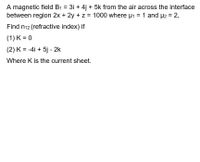Question

Transcribed Image Text:A magnetic field B1 = 3i + 4j + 5k from the air across the interface
between region 2x + 2y + z = 1000 where u1 = 1 and µ2 = 2,
Find n12 (refractive index) if
(1) K = 0
(2) K = -4i + 5j - 2k
Where K is the current sheet.
Expert Solution
This question has been solved!
Explore an expertly crafted, step-by-step solution for a thorough understanding of key concepts.
Step by stepSolved in 5 steps

Knowledge Booster
Similar questions
- A uniform electric field is increasing at a constant rate over time. If the displacement current through a 1.0 cm2 surface area perpendicular to the electric field vector is 3.0 nA, find the rate at which the electric field changes.arrow_forwardA sample of 1H in the equilibrium condition in a static magnetic field BO is excited by a short circularly polarized RF pulse. The RF pulse is a magnetic field in the transverse plane B₁(t) = B₁(t)e-i²πvot G₂ where vo is the Larmor frequency of the sample. The envelope of the RF pulse is a triangle function with parameter T: (1-7), 0≤t≤2T otherwise B₁ (t)= = { 0, (a) Find the tip angle of the magnetization vector as a function of t for 0 ≤ t ≤ 2T. (b) What is the value of T to make B1(t) a π/2 pulse?arrow_forwardAn argon gas laser produces a cylindrical beam of light having a cross sectional area A = 4 x 10-6 m². The average power of the beam is P. It is found that the average energy stored in 3 m length of the beam is 30 nJ. What is P? (1 nj = 10-9 J) Hig 30 nW 3 W 6 Warrow_forward
- An argon-ion laser produces a cylindrical beam of light whose average power is 0.743 W. How much energy is contained in a 3.17-m length of the beam? Number Units → Larrow_forwardA cloud of atoms is excited by a laser pulse and then emits electromagnetic radiation, which is detected by a spectrometer. At the detector, the amplitude of the field is given by: E(t) = E0e-i[omega]0t - t/2[tao], where E0 is a compex constant, while [omega]0 and [tao] are real constants. a) Determine the detected time-dependent intensity I(t) = |E(t)|2. b) Determine the frequency resolved intensity I([omega]) = |E([omega])|2, where E([omega]) = The integral from 0 to infinity of E(t)*ei[omega]t dt. c) Determine the frequency [omega]max where I([omega]) attains its maximum, as well as the full width at half maximum [delta omega], defined by I([omega]max +/_ [delta omega]/2) = (1/2)I([omega]max). d) Sketch the time-dependent and frequency-resolved intensities I(t) and I([omega]). Image attached with the original formattingarrow_forwardLight with an intensity of 10−10W/m2 is shone perpendicular to the surface a metal that has one free electron per atom. Distance between atoms approx 2, 6A˚. Based on the notion of light as a wave and the assumption that light evenly distributed over the entire metal surface, (a) how much energy each electrons per second? (b) if the electron binding energy is 4.7eV , how long does the electron collect energy to escape the metal surface?arrow_forward
arrow_back_ios
arrow_forward_ios